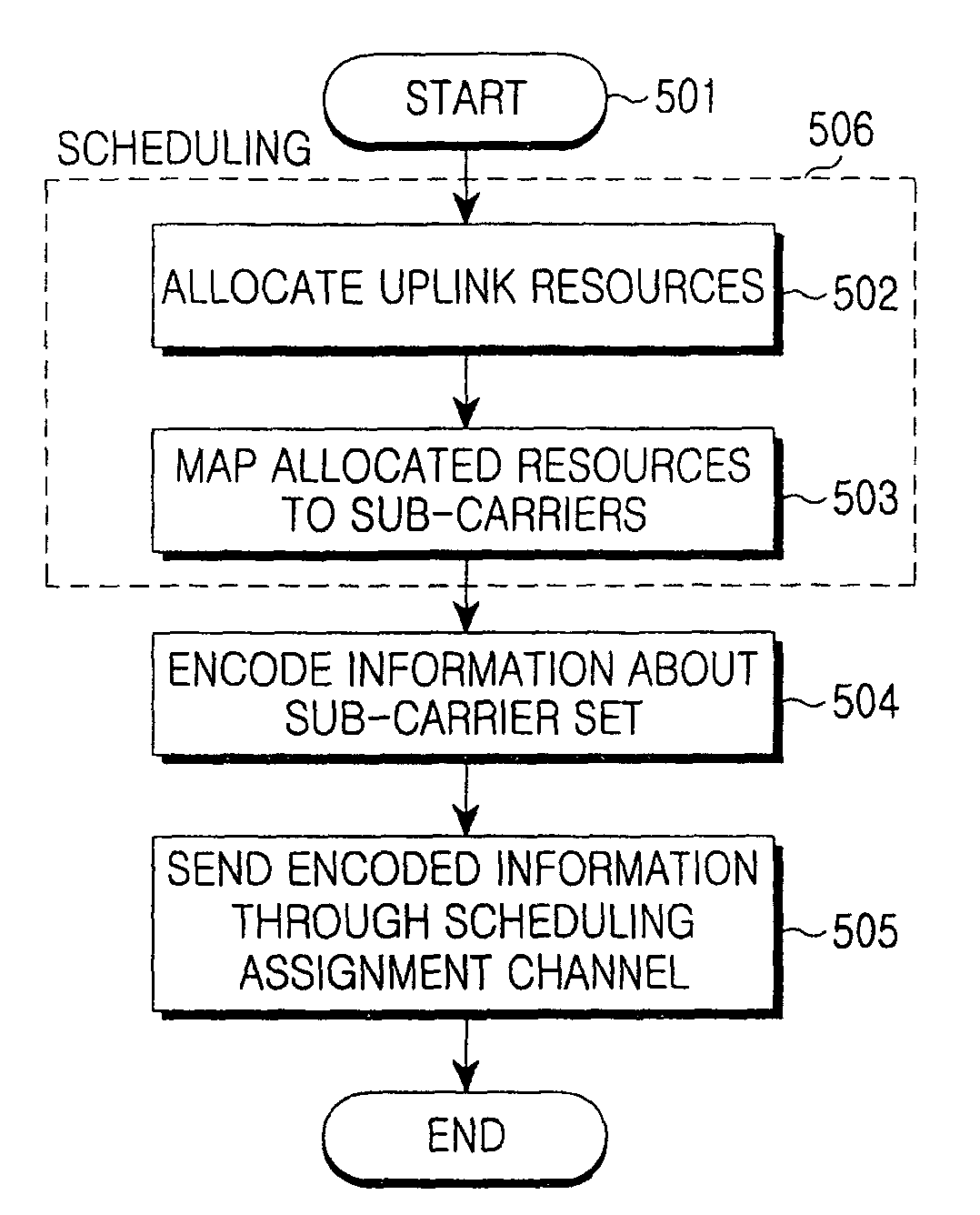Method and transmission apparatus for allocating resources to transmit uplink packet data in an orthogonal frequency division multiplexing system
a technology of orthogonal frequency division and transmission apparatus, applied in multi-frequency code systems, transmission path sub-channel allocation, wireless communication, etc., can solve problems such as increase in peak to average power ratio (papr) and achieve efficient allocation of resources
- Summary
- Abstract
- Description
- Claims
- Application Information
AI Technical Summary
Benefits of technology
Problems solved by technology
Method used
Image
Examples
first exemplary embodiment
[0060]A first method based on flexible resource allocation in accordance with the first exemplary embodiment is described below.
[0061]In the first exemplary embodiment, a base station schedules signal resources allocated to a terminal in the same way, regardless of DFDMA and LFDMA.
[0062]FIG. 5 is a flowchart illustrating a process for allocating uplink resources scheduled by the base station for an uplink transmission of a terminal, in accordance with the first exemplary embodiment of the present invention. An uplink resource allocation process in accordance with the first exemplary embodiment will be described below with reference to FIG. 5.
[0063]When the uplink transmission is required (Step 501), the base station allocates uplink (UL) resources to each terminal (Step 502). Subsequently, the base station considers terminal states and maps the allocated uplink resources to possible sub-carriers (Step 503).
[0064]At this time, resources allocated to a terminal using the DFDMA are map...
first example of first exemplary embodiment
[0067]FIG. 6 illustrates a first example of the first exemplary embodiment.
[0068]Reference numeral 600 denotes uplink resources in the time and frequency domains. In the time domain, a time units are designated as indicated by reference number 601 and is used as a scheduling unit. One or more OFDM symbols can be set in one time unit.
[0069]Furthermore, a frequency bandwidth is configured with multiple sub-carriers as indicated by reference numeral 602. In other words, the base station signals a set of allocated sub-carriers to each terminal in every time unit. The sub-carrier set is signaled using an interval between a sub-carrier of a start point (S) 603 and a subsequent sub-carrier, a repetition factor (R) 605, and the number of sub-carriers (N) 604.
[0070]In terms of the resource set allocated to an arbitrary terminal, the interval between sub-carriers, R, is set to one value. Thus, with DFDMA, using equal-interval sub-carriers can be supported. When an equal interval is set to a v...
second example of first exemplary embodiment
[0080]In the second example of the first exemplary embodiment, the flexibility of a sub-carrier set mapped to allocated resources and the signaling overhead are simultaneously considered.
[0081]FIG. 9 illustrates a basic concept of the second example of the first exemplary embodiment.
[0082]In FIG. 9, reference numeral 900 denotes uplink resources on time and frequency domains. In the time domain, a time unit is designated as indicated by reference number 901 and is used as a scheduling unit.
[0083]One or more OFDM symbols can be set in one time unit. Furthermore, the frequency bandwidth is configured with multiple sub-carriers as indicated by reference numeral 902. That is, the base station signals a set of allocated sub-carriers to each terminal in every time unit.
[0084]In relation to the sub-carrier set in a signaling method, a total frequency bandwidth is divided into frequency blocks with a block length (L) 903, and sub-carriers are transmitted only in the blocks. When the total f...
PUM
 Login to View More
Login to View More Abstract
Description
Claims
Application Information
 Login to View More
Login to View More - R&D
- Intellectual Property
- Life Sciences
- Materials
- Tech Scout
- Unparalleled Data Quality
- Higher Quality Content
- 60% Fewer Hallucinations
Browse by: Latest US Patents, China's latest patents, Technical Efficacy Thesaurus, Application Domain, Technology Topic, Popular Technical Reports.
© 2025 PatSnap. All rights reserved.Legal|Privacy policy|Modern Slavery Act Transparency Statement|Sitemap|About US| Contact US: help@patsnap.com



